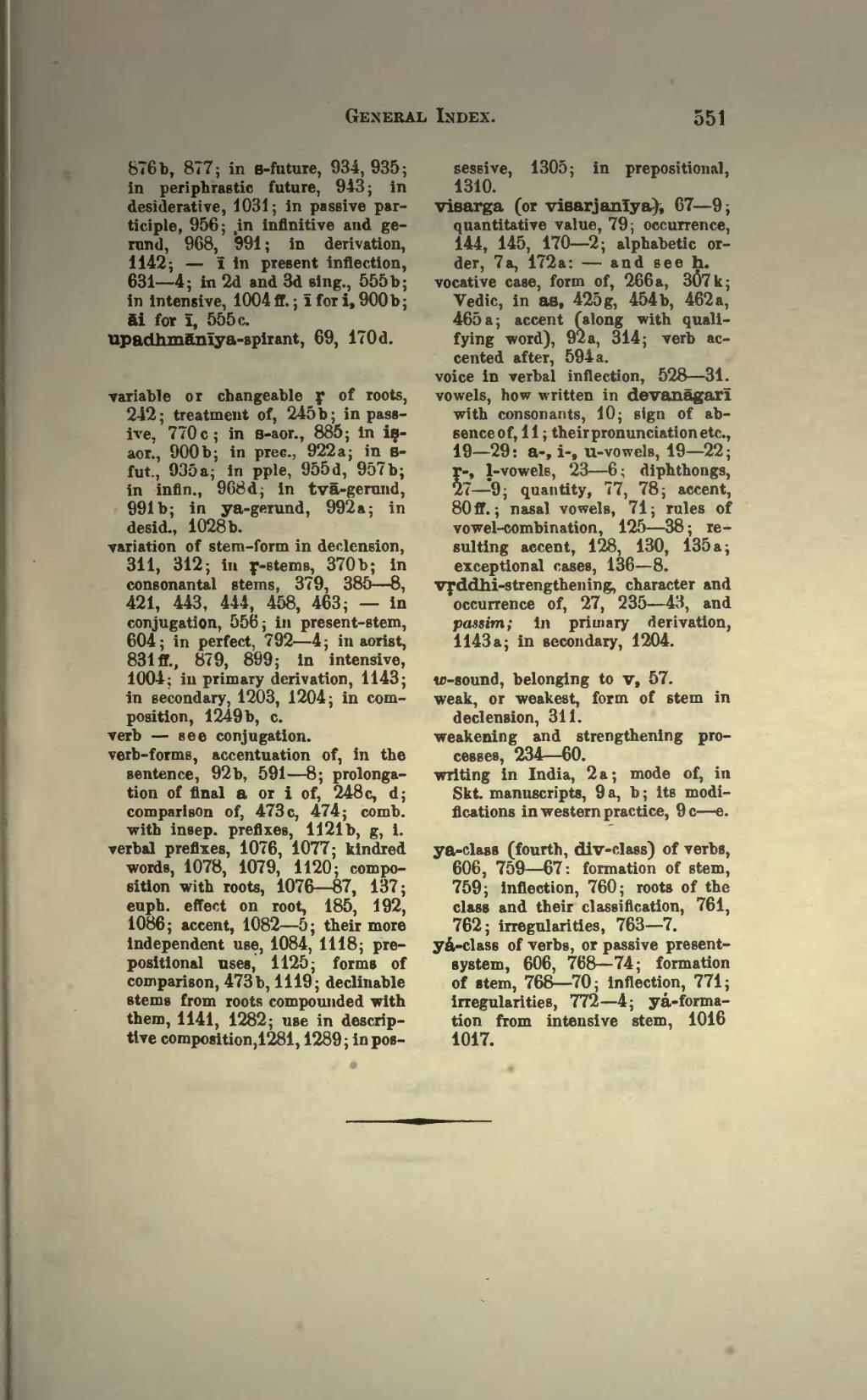876 b, 877; in s-future, 934, 935; in periphrastic future, 943; in desiderative, 1031; in passive participle, 956; in infinitive and gerund, 968, 991; in derivation, 1142; — ī in present inflection, 631–4; in 2d and 3d sing., 555 b; in intensive, 1004 ff.; ī for i, 900 b; āi for ī, 555 c.
upadhmānīya-spirant, 69, 170 d.
variable or changeable ṛ of roots, 242; treatment of, 245 b; in passive, 770 c; in s-aor., 885; in iṣ-aor., 900 b; in prec., 922 a; in s-fut., 935 a; in pple, 955 d, 957 b; in infin., 968 d; in tvā-gerund, 991 b; in ya-gerund, 992 a; in desid., 1028 b.
variation of stem-form in declension, 311, 312; in ṛ-stems, 370 b; in consonantal stems, 379, 385–8, 421, 443, 444, 458, 463; — in conjugation, 556; in present-stem, 604; in perfect, 792–4; in aorist, 831 ff., 879, 899; in intensive, 1004; in primary derivation, 1143; in secondary, 1203, 1204; in composition, 1249 b, c.
verb — see conjugation.
verb-forms, accentuation of, in the sentence, 92 b, 591–8; prolongation of final a or i of, 248 c, d; comparison of, 473 c, 474; comb. with insep. prefixes, 1121 b, g, i.
verbal prefixes, 1076, 1077; kindred words, 1078, 1079, 1120; composition with roots, 1076–87, 137; euph. effect on root, 185, 192, 1086; accent, 1082–5; their more independent use, 1084, 1118; prepositional uses, 1125; forms of comparison, 473 b, 1119; declinable stems from roots compounded with them, 1141, 1282; use in descriptive composition, 1281, 1289; in possessive, 1305; in prepositional, 1310.
visarga (or visarjanīya), 67–9; quantitative value, 79; occurrence, 144, 145, 170–2; alphabetic order, 7 a, 172 a: — and see ḥ.
vocative case, form of, 266 a, 307 k; Vedic, in as, 425 g, 454 b, 462 a, 465 a; accent (along with qualifying word), 92 a, 314; verb accented after, 594 a.
voice in verbal inflection, 528–31.
vowels, how written in devanāgarī with consonants, 10; sign of absence of, 11; their pronunciation etc., 19–29: a-, i-, u-vowels, 19–22; ṛ-, ḷ-vowels, 23–6; diphthongs, 27–9; quantity, 77, 78; accent, 80 ff.; nasal vowels, 71; rules of vowel-combination, 125–38; resulting accent, 128, 130, 135 a; exceptional cases, 136–8.
vṛddhi-strengthening, character and occurrence of, 27, 235–43, and passim; in primary derivation, 1143 a; in secondary, 1204.
w-sound, belonging to v, 57.
weak, or weakest, form of stem in declension, 311.
weakening and strengthening processes, 234–60.
writing in India, 2 a; mode of, in Skt. manuscripts, 9 a, b; its modifications in western practice, 9 c–e.
ya-class (fourth, div-class) of verbs, 606, 759–67: formation of stem, 759; inflection, 760; roots of the class and their classification, 761, 762; irregularities, 763–7.
yá-class of verbs, or passive present-system, 606, 768–74; formation of stem, 768–70; inflection, 771; irregularities, 772–4; yá-formation from intensive stem, 1016, 1017.
